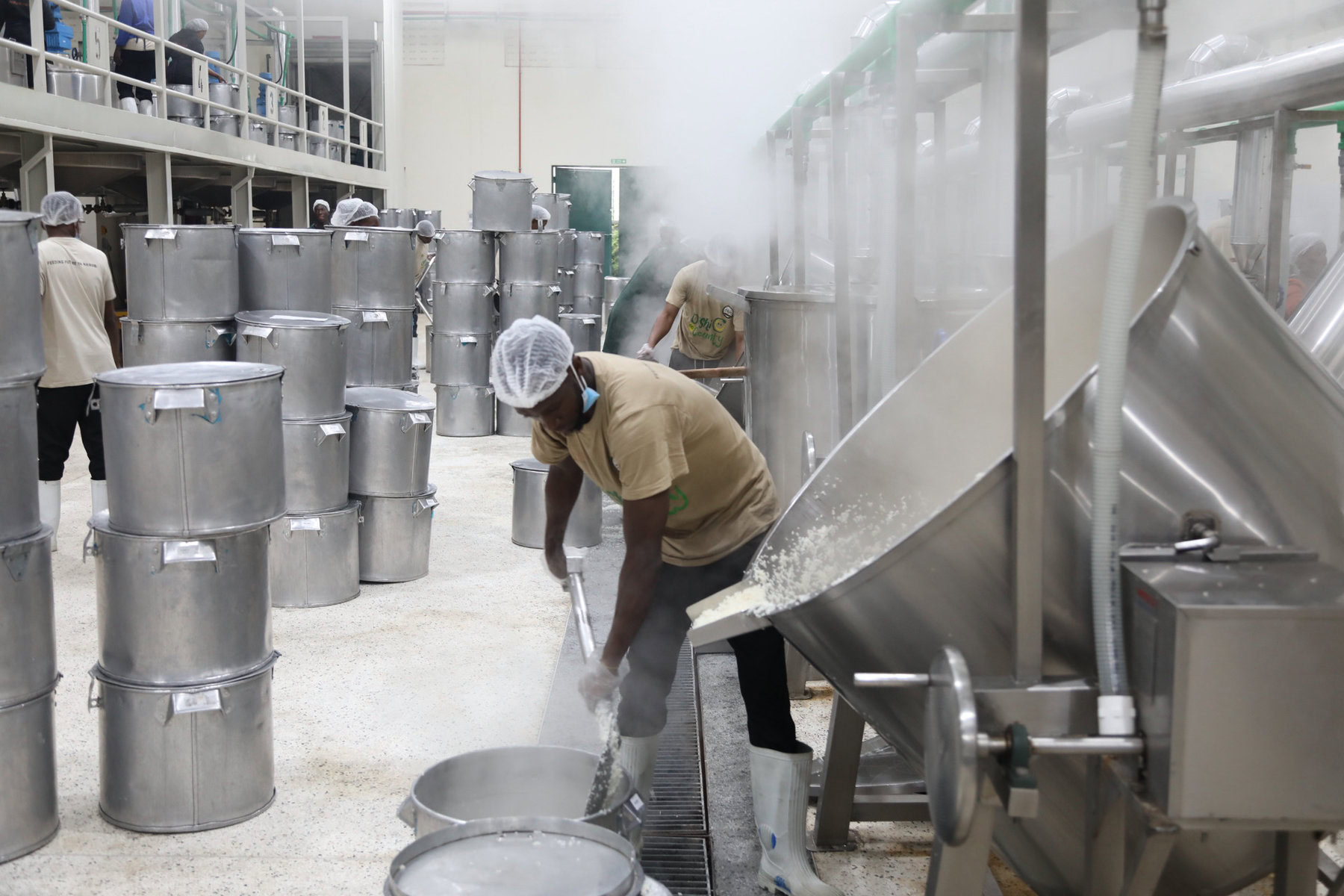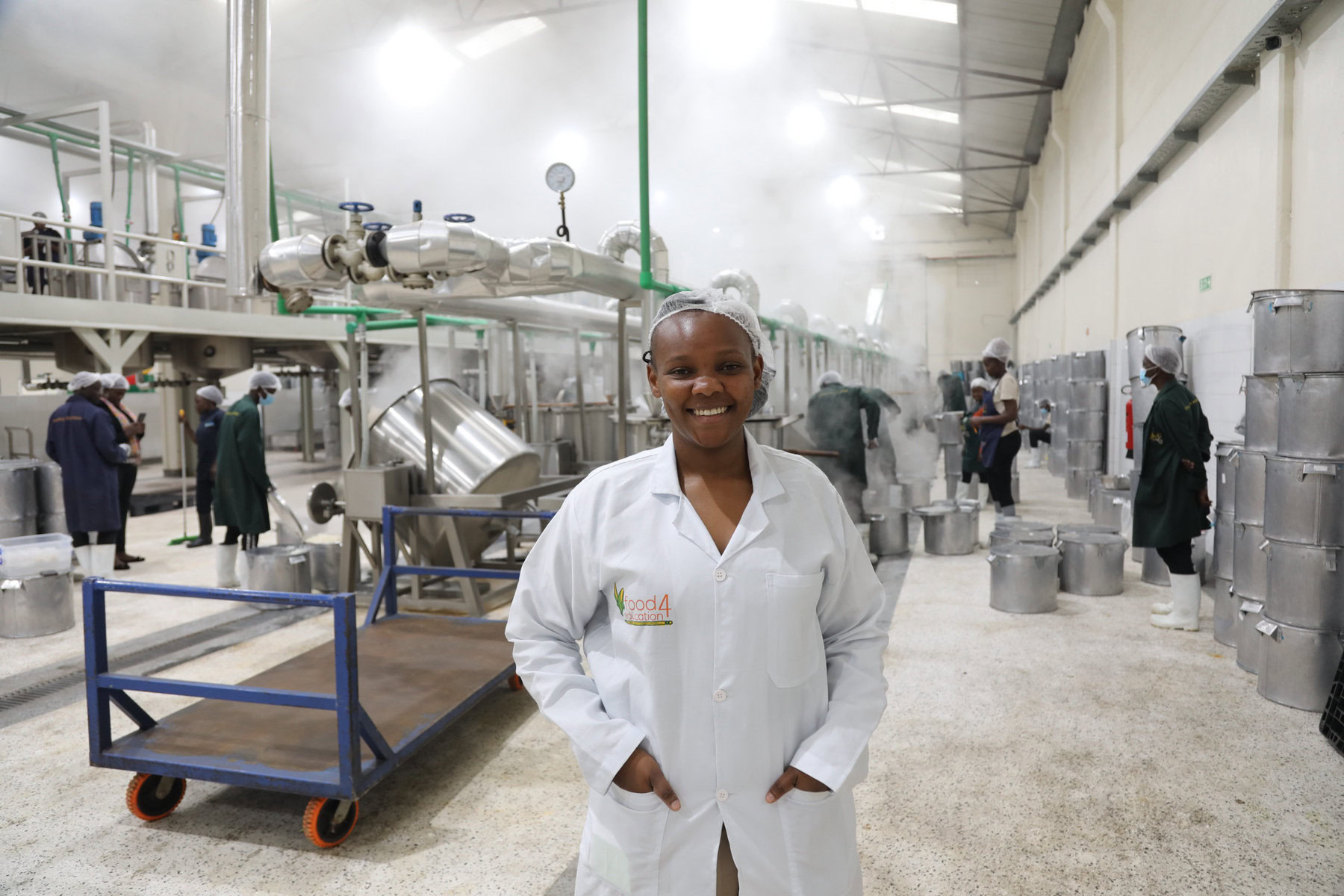At 7 a.m., Nairobi’s Giga Kitchen almost resembles an 18th-century factory in the midst of the Industrial Revolution. Giant steam-powered cookers churn out great clouds of mist as troops of workers in dark overalls scurry around with shovels in hand.
But there are remarkably modern aspects to the 32,000-square-foot warehouse on the outskirts of Kenya’s capital city. The steam — produced by a pair of two-ton machines powered by “eco briquettes” of compressed sawdust — is channeled via a network of tubes linked to cookers filled with green lentils, mung beans, black-eyed peas, onions and more. Electric vehicles zip by with containers of the food, which are weighed and have their temperature recorded before being loaded onto trucks.

“We even sterilize the [used] cooking containers with steam,” says Carol Kinuthia, the 24-year-old manager of the Giga Kitchen, as a huge column of warm air wafts out from a rumbling cooker beside her. “Nothing goes to waste here.”
This gargantuan food hub, which launched in August 2023, produces 60,000 meals a day for school kids across Nairobi. Up to 900 containers of locally sourced, healthy meals, each weighing about 45 kilograms, are dispatched to the city’s schools every morning.
The Giga Kitchen is the jewel in the crown of Food4Education, a Kenyan nonprofit using high-tech, low-carbon and centralized kitchens to feed students en masse in what is Africa’s largest locally led and independently run school feeding program.
All scrolling images are by Peter Yeung.
“The problem is that kids were fainting, and getting hungry,” says Wawira Njiru, the Kenyan founder and CEO of Food4Education. “Why not just feed them? If they are hungry, they can’t learn. And that can have a lifetime impact.”
Njiru argues child malnutrition is a solvable problem and one that has far-reaching consequences for a child’s life prospects since hunger means children lack the energy to learn effectively. Therefore, by providing cheap and nutritious food through school meals, class attendance and education performance will improve, and in turn there will be multiple larger and long-term benefits. “Filling tummies and awakening possibilities,” as Food4Education’s motto describes it.
A large and growing body of research has shown the value of school feeding schemes, from increased enrollment and improved student retention to reduced absenteeism and an overall improved learning capacity. (In Ghana, a study found that a school feeding program led to a 14 percent increase in literacy scores, 13 percent in mathematics, and 8 percent in reasoning ability). The effects are particularly notable for girls who are living in poverty, suggesting the interventions can boost equality.
Weighed down by negative news?
Our smart, bright, weekly newsletter is the uplift you’ve been looking for.While Food4Education is carrying out an ongoing study, it says that preliminary data shows its efforts have led to a 25 percent increase in student enrollment and a 93 percent rise in the number of pupils regularly attending school.
Meanwhile, a research paper on food systems and school meals presented at COP28, the UN climate change conference, last year stated that feeding programs had “transformative potential” to make food systems more resilient, equitable and sustainable.

“People tend to think school meals schemes are about food, but it’s about a lot more than that,” says Donald Bundy, a professor of epidemiology and development at the London School of Tropical Hygiene and Medicine who has long studied Kenya.
“It’s about the wellbeing of children; establishing the right sorts of eating habits at that age sets them on a lifelong journey for better health. It’s one of the few ways to combat obesity longer term.”
Bundy — who is also leading a research initiative for the School Meals Coalition, a partnership of 98 national governments launched in 2021 aimed at scaling up and improving school meals provisions — argues that development funding has historically been divided between health and education, with little collaboration between the two. Yet, for him, schools are one of the most effective places to deliver health interventions.
“That’s where the school meals program comes in,” he says.

Other research bears out Bundy’s argument. According to a report in 2023 by the UN’s World Food Programme, for every $1 invested in a school feeding program, there is a $9 return, since they “deliver returns across multiple sectors,” including education, but also health, agriculture and social protection.
Yet despite these proven benefits, more than 150 million children across the globe are missing out on meals, according to Action Against Hunger, and around 64 million children in Africa under five years of age – or one in three – are experiencing severe child food poverty, a report by UNICEF in June found. In Kenya, almost 80 percent of children in public primary schools have no access to a nutritious school meal.
“We can put an end to this,” says Njiru. “We have a blueprint that works.”
Food4Education’s 19 kitchens in Nairobi, which produce between 10,000 and 60,000 meals each per day, are in a program run in partnership with the Nairobi County government. They now provide subsidized meals to all of the city’s 216 public primary schools, offering universal school feeding for the first time.
Before the launch of Food4Education, Njiru built her first kitchen — a corrugated iron sheet structure in her hometown of Ruiru, about 15 miles from Nairobi — in 2012 as part of her own initiative, and it fed 25 pupils at the local school.
Her ambition skyrocketed after she saw a YouTube video about the Akshaya Patra Foundation, an Indian school lunch program that feeds two million children daily. In 2017, she then visited the project in person. India, which in 2001 passed a law that requires all school children to be fed lunch meals, is widely seen as the country that revolutionized the model, and now feeds as many as 100 million children per day.
“It opened my eyes to the possibilities,” adds Njiru. “But you can’t copy-paste these projects; you must customize them to different contexts.”
Even wealthy nations in the Global North are following in the footsteps of India and Kenya. During COVID, the US implemented a universal school meals program, and while that national effort has come to an end, states such as California have made the move permanent.

The next great obstacle for Food4Education is that its goal of feeding millions of kids a day requires a big scale-up of school feeding in rural areas, which pose different challenges from the urban areas in which it has largely operated to date. The centralized model may no longer work.
“How do we build a model with the efficiency of urban but the practicality of rural?” says Njiru. “That’s what we’re working on.”
Nonetheless, Food4Education’s urban model has already proven a roaring success, and earlier this year Njiru received the Skoll Foundation’s prestigious Social Innovator Award in recognition of her organization’s achievements.

At the Giga Kitchen, where a staff of 49 work over two shifts, cooking usually starts at 10 p.m. the night before. The organic, vegetarian produce is supplied by thousands of local small-scale farmers, who benefit from the stable income, and around half of the workers serving the lunches at the schools in Nairobi are parents, often mothers.
At the Olympic Primary School in Kibera, the largest slum in Kenya, nearly 5,000 children receive the school meals every day.
At lunchtime, hundreds of energetic pupils swarm around the playground, queuing up with tupperware they bring from home (in order to reduce waste) to receive their portion of the day. Kids pay for their subsidized lunches — sold at just 5 Kenyan shillings, or about $0.04 — using smart wristbands provided to them by the program.
Many of the parents in Kibera are jobless or have meager earnings, according to the school’s headteacher Sinas Opiyo Okumu, meaning they often can’t afford to pay for standard-priced lunches for their children.
“It helps me a lot, it’s better for work-life balance,” says Elizabeth Ochau, a single mother with two kids who now works at the school for around three hours a day.
But Okumu says that since the school started working with Food4Education, student attendance has improved. “A child cannot learn on an empty stomach,” he says. “I’ve seen the change these meals have made with my own eyes.”



